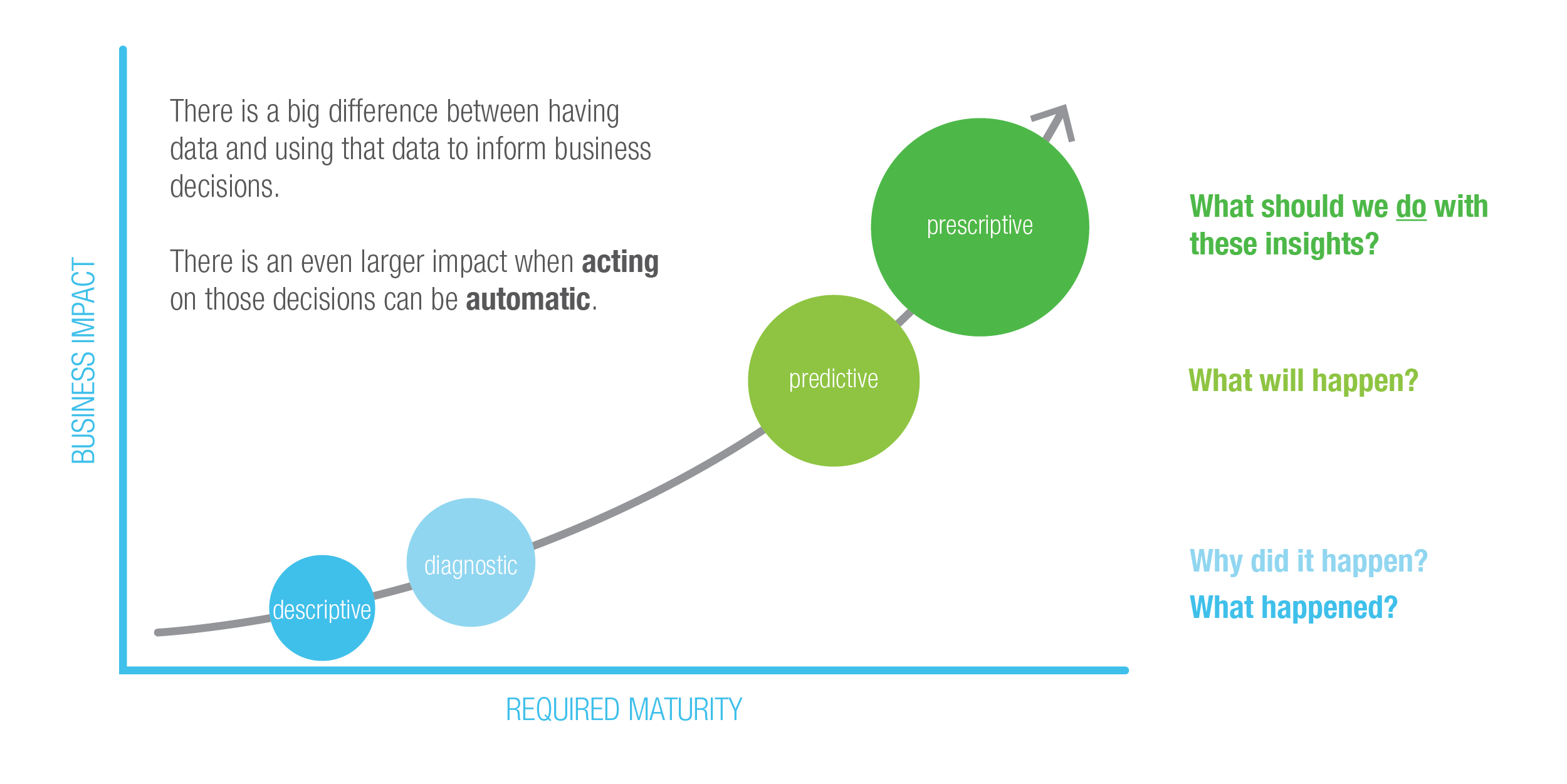Large language models (LLMs) like ChatGPT and GitHub Copilot are rapidly…
Many people believe their companies aren’t quite ready to get started with machine learning or artificial intelligence. They will say, “We don’t have a data scientist,” or, “Our data isn’t clean enough.” However, companies that have begun to address these obstacles and embark on their analytics journey have started to separate from the pack.

Forward-thinking companies are graduating into predictive and prescriptive analytics, increasing their revenue and discovering insights while other companies are still struggling to deliver descriptive and diagnostic analytics. Not being completely ready can no longer be an excuse for not getting started.
There are many ways you can start applying machine learning and data science, and they are attainable for any company. These methods will provide immediate value and get people excited about the possibilities of data science and machine learning along the way.
Ways to Get Started with Machine Learning
Seek Out Education
Knowledge is power. With increased demand for data science skills and resources, there has been an increase in courses and training around the complex topics and tactics providing these increasingly valuable skills. Many such courses are offered online, led by reputable universities and machine learning experts.
There is an extreme amount of value in understanding the foundational concepts of machine learning, even if you are never going to become an expert. This is especially true if you are leading a team tasked with driving analytics initiatives or have recognized the need for your organization to get on board with maturing its data practices.
We offer a complimentary learning session, Machine Learning & Muffins, designed around educating individuals regardless of their background. It moves participants from asking “What is machine learning?” to a basic understanding of how machine learning works. It also shows how to recognize the best potential use cases so advanced analytics can gain a foothold at the host company. If you are looking at dipping your toe in the water of machine learning it’s a great way to demystify the topic.
Ask a Specific Question
Machine learning is very good at predicting the answer to certain types of specific questions. It can predict numerical answers to questions such as “How many?” or “How much?” It can predict the classification of data points by answering questions like “Yes or no?” or “Which one?” It is also very good at finding ways to group data points together based on often-unidentifiable similarities. Being able to ask questions so that a machine learning model can answer them is a learned skill, but it doesn’t take much time or in-depth technical knowledge to master.
You could ask a machine learning model “What product should my company promote next month?” However, this would be difficult to train for without a very complex model, because it requires consideration of so many business rules and human assumptions. But there are different ways to ask many business questions, which can inform business decisions and allow them to be made quickly and with enhanced confidence.
With that in mind, you might instead ask a machine learning model how much of each product will sell next month. You could then make a machine learning model to predict exactly that and use that knowledge to inform the next month’s promotion.
Taking it a step further, the more specific the question is the less data is needed to train an accurate model. If you want to know how much of a specific product will sell next month, it requires much less historical data than if you wanted to know how much of every product is going to sell in the next month. When starting small, it’s wise to consider what you should ask first.
You could base the questions for a machine learning model around what you learn from descriptive statistics. In the above case you could analyze your most (or least) profitable products and focus machine learning on predicting the sales volumes of those products. Doing so would help inform the decisions you need to make around production, marketing promotions and more.
Gain Value Even Without a Fully Operationalized System
Machine learning can be helpful and provide insights even if it isn’t part of an end-to-end, fully automated, artificial intelligence solution. It can provide varying degrees of decision support by highlighting the most influential or important elements of your data or by finding previously unseen similarities and differences.
This especially applies with clustering, which doesn’t require human supervision to find correlations between data points. For example, you can use clustering to identify new, unique customer segments. This machine learning customer segmentation process can be based on many more factors than just the traditional demographic information (e.g., age, gender and income bracket) frequently used today.
Another relatively simple technique is called principal component analysis. PCA can look through your data and find the biggest differentiators within your data. For example, by using PCA to analyze the factors affecting the sale price of a car, you may find the make of a car plays a much larger role in the price than other factors.
This is easy to see if we compare the range of models available from both Ford and Mercedes-Benz. PCA will show us that, all other factors being equal, a Mercedes would cost more than a Ford. This example is obvious, but when you’re dealing with dozens or hundreds of product features, PCA can help you identify the most important factors of your best-selling products.
Fail Fast
It’s worth noting that machine learning projects are very iterative and experimental. Not every business question or use case is going to be a great application of machine learning. Being able to recognize that in an appropriate amount of time will give you more time and resources to dedicate to the golden nuggets you are able to uncover.
It’s good to set checkpoints in a project so you are constantly evaluating both progress and roadblocks. Don’t succumb to the sunk cost fallacy; there will be times where an accurate machine learning model is not viable for a specific question. And that’s OK if you have set up the proper checks and balances. In fact, it should be encouraged because it opens you up to exploring many more use cases, giving you the best chance to land on opportunities for massive savings or increased revenue.
For example, you might suspect that a customer’s shoe size is an indication of how much they will buy from your shop. You start to build a machine learning model to test your theory, but it’s not very accurate. So you build a more complex model and gather a lot more data, but it’s still not very accurate. Instead of reconsidering your hypothesis, you hire dedicated staff to develop website enhancements to collect shoe size when a customer first comes to your site.
Before you know it you’ve spent a year and a lot of capital trying to predict how much someone would buy based on the size of their feet, instead of pivoting to discover that 50% of your customer purchases are leads from your new referral program. Setting proper deadlines would keep your timeline from blowing up and let you and your team know when it’s time to try a different approach. Or if your data and models look promising, you can continue with confidence and metrics to show leadership of your success.
The Importance of a Strong Pilot Project
One of the biggest challenges with adopting machine learning and advanced analytics as part of your strategy is that it usually requires a culture shift as well. This is why it’s important to have a strong pilot project. There should be a tangible impact and the pilot should relate to as many departments throughout your company as possible. It should excite people about the possibilities of machine learning.
Doing a pilot project will also give your company a stronger assessment of where it is on the analytics curve. How hard was it to get data? What did you already know about the data? How did the project surprise you? The answers to these questions will give you a better understanding of your company’s placement on the curve and how you can move up.
However, picking the right pilot project can be difficult. You need to have access to the right data, and the project should be promising in terms of your ability to achieve your desired machine learning outcomes. The difficulty is even greater if you don’t have an in-house data scientist or machine learning engineer.
Consider Finding a Trusted Consulting Partner
Working with a machine learning and data science consulting company can give you a taste of the benefits of data science and machine learning for your company without having to make the full commitment of hiring a data scientist. The “sexiest job of the 21st century,” according to Harvard Business Review, means people with these skills are in demand and can be a costly hire. This is especially true for companies that haven’t fleshed out an advanced analytics strategy.
Leaning on a trusted consulting partner for your initial projects allows you to take a phased approach and learn from vetted experts before making long-term financial and strategic commitments. Fortunately, Zirobi has experienced and vetted data scientists, with certifications in data science and machine learning from Microsoft Azure and Amazon Web Services to back them up, so you don’t have to worry about finding your own to get started.
What about trying to decide on a good pilot project? The right consulting company can help you determine which projects you have the right data for and that would have the most impact — and then help you implement those projects. We have led a number of organizations through pilot projects, like one that uncovered an additional $370,000 in annual revenue for one urban hospital.
Another advantage of working with a machine learning consulting company is that your IT department and data resources can remain dedicated to their own tasks. The right consulting partner doesn’t just bring a data scientist to the table. It brings a complete team, with the skills to tackle infrastructure, security and project management needs to complete the project on time and without sidetracking your day-to-day operations. Your staff offer crucial domain knowledge and understanding of your business, while the consulting staff can transfer knowledge to your team for a smooth hand off and a jumping off point to tackle future initiatives solo.
The Best Time to Get Started is Now
Well really, the best time to get started with data science projects and machine learning was 10 years ago, but the second best time is today. Every day delayed leads to more time for your competition to get ahead, claiming your customers and revenue along the way.
As we’ve seen, it doesn’t take a lot to get started; with just a sample extract of data, we’ve helped companies gain new insights and hard ROI from data science and machine learning. With some initiative and guidance you can get on track for fully automated, prescriptive analytics.
As mentioned above, a data science project through our Spark program helped an urban hospital move up to the analytics curve. We hosted a brainstorming session to evaluate what some of the hospital’s current problems were and narrowed our focus to analyze the usage of its emergency department.
Because of recent changes in state laws, the hospital only received partial reimbursement from Medicaid in cases where Medicaid patients came to the emergency department and received non-emergency diagnoses. We analyzed over 24,000 visits and 90,000 diagnoses from a year’s worth of visits to the emergency room. Through that analysis, we found a crucial insight: There were more than 1,400 visits with a key documentation characteristic that would allow them to be considered emergencies.
By appealing these cases and increasing the reimbursement from non-emergency rates to emergency rates, the hospital could recoup $370,000 in revenue. And by proactively monitoring and adjusting future claims, it can expect to add a similar amount to its bottom line each year going forward. This project was completed in under a month, had a real financial impact on the medical center and demonstrated to all of the hospital’s departments how useful data science can be.
That facility didn’t have a data scientist or a fancy analytics environment, but it took the first steps to uncover value from its data. Are you ready to get started? Zirobi, a technology data and insights company established by leading communications, IT and sales experts, is here to help you every step of the way.
We speak the language of business and technology to create customer-centric organizations. Contact us today to learn more.




This Post Has 0 Comments